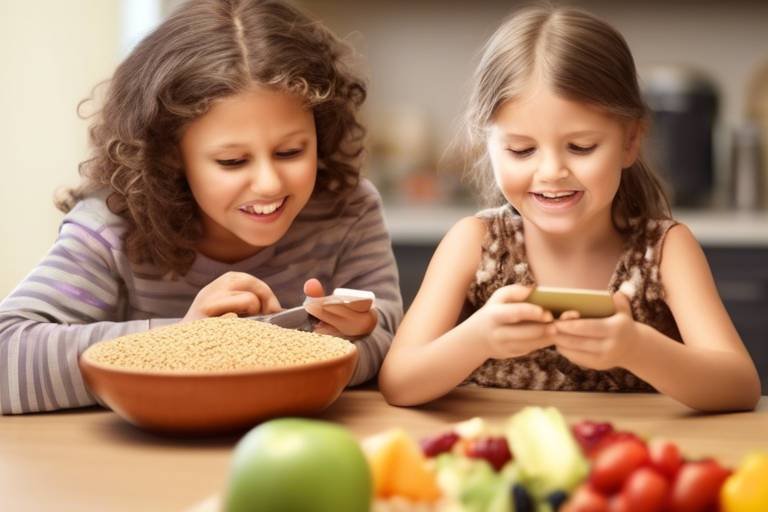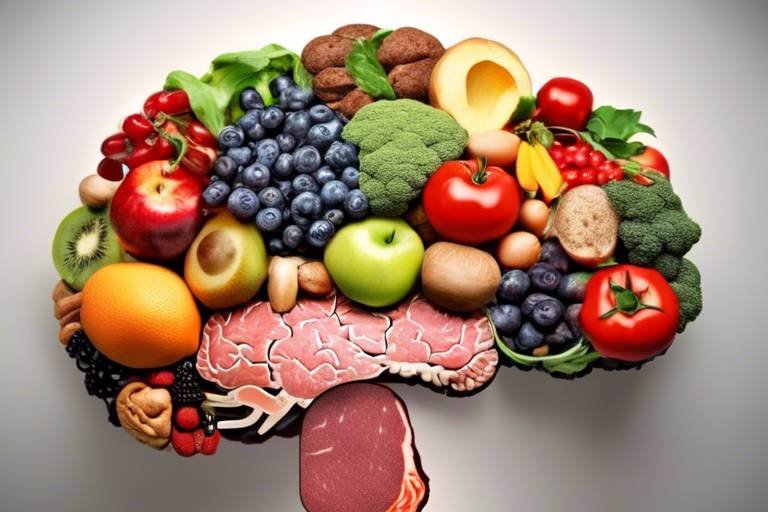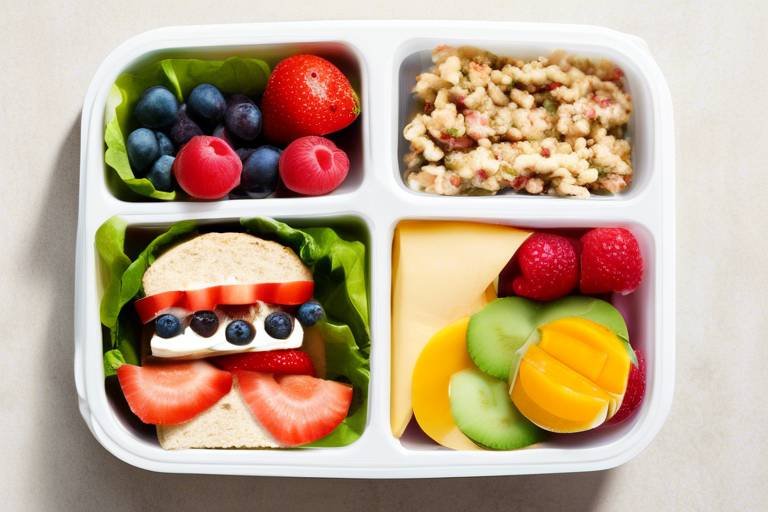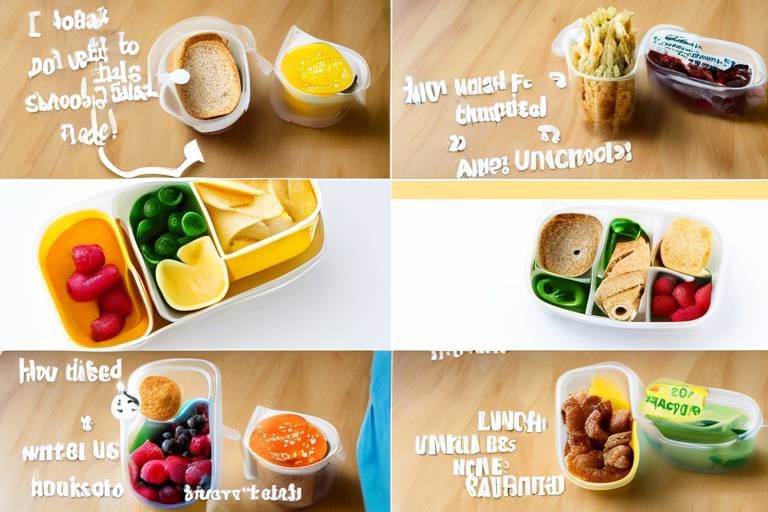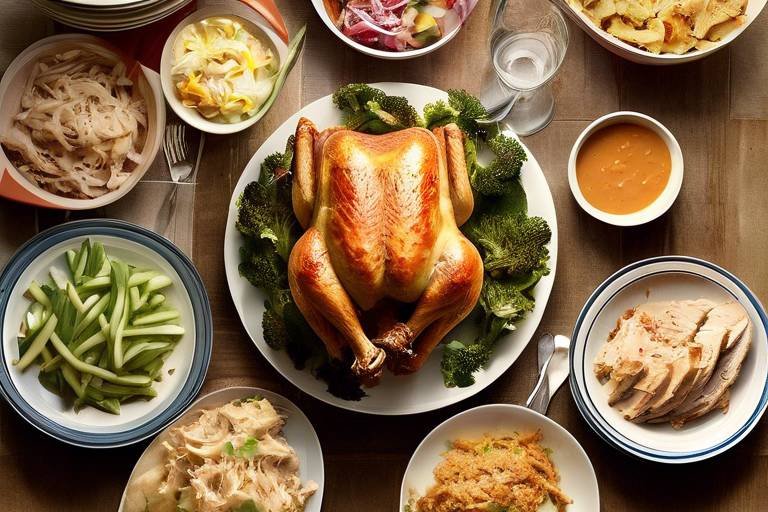Easing Your Kids into a High Fiber Diet
Introducing your kids to a high fiber diet may sound like a daunting task, but it can be a fun and rewarding journey! Fiber is an essential component of a healthy diet, playing a significant role in maintaining your child's digestive health and overall well-being. But what exactly is fiber, and why is it so important for our little ones? In this article, we will explore practical strategies and tips for integrating fiber into your children's meals in a way that is both enjoyable and beneficial. By understanding the importance of fiber and learning how to make it appealing, you can set your kids on a path to a healthier lifestyle.
Dietary fiber is a type of carbohydrate that the body cannot digest. It comes in two forms: soluble and insoluble. Soluble fiber dissolves in water and can help lower blood cholesterol and glucose levels. On the other hand, insoluble fiber adds bulk to the stool and aids in moving food through the digestive tract. Both types of fiber are crucial for maintaining a healthy digestive system for children. When kids consume adequate amounts of fiber, they are less likely to experience digestive issues, which can lead to a happier and healthier life.
Incorporating high fiber foods into your child's diet can lead to a plethora of health benefits. Not only does fiber aid digestion, but it also helps maintain a healthy weight and lowers the risk of chronic diseases later in life. Think of fiber as a superhero for your child's gut! Here are some key benefits:
- Improved Digestion: Fiber promotes regular bowel movements, reducing the likelihood of constipation.
- Weight Management: High fiber foods are often more filling, helping kids feel satisfied and less prone to overeating.
- Chronic Disease Prevention: A diet rich in fiber can lower the risk of conditions such as diabetes and heart disease.
One of the most significant advantages of a fiber-rich diet is its impact on digestion. Fiber acts like a broom, sweeping through the intestines and promoting regular bowel movements. This is particularly important for children, as they can be prone to digestive issues. A fiber-rich diet can alleviate constipation and support overall gut health, allowing your kids to feel their best.
Constipation is a common issue among children, often leading to discomfort and frustration. To combat this, it's essential to ensure your kids are getting enough fiber in their diet. Here are some effective tips:
- Encourage them to eat fruits and vegetables with the skin on.
- Introduce whole grains, such as whole wheat bread and brown rice.
- Make sure they drink plenty of water to help fiber do its job.
A high fiber diet plays a vital role in supporting a healthy gut microbiome. This is the community of beneficial bacteria living in the intestines, which is crucial for digestion and immune function. When children consume fiber, it acts as food for these good bacteria, helping them thrive. Think of it as giving a feast to the little warriors that keep your child's gut healthy!
So, what are some foods that are rich in fiber and suitable for children? Here’s a quick overview:
| Food Group | Examples | Fiber Content (per serving) |
|---|---|---|
| Fruits | Apples, Bananas, Berries | 3-5 grams |
| Vegetables | Carrots, Broccoli, Spinach | 2-4 grams |
| Whole Grains | Oats, Quinoa, Brown Rice | 3-6 grams |
| Legumes | Beans, Lentils, Chickpeas | 6-8 grams |
Incorporating these foods into meals can be as simple as adding berries to breakfast cereal or including beans in a tasty chili. The possibilities are endless!
Getting kids to eat fiber-rich foods can sometimes feel like pulling teeth, but it doesn't have to be that way! With a little creativity, you can make high fiber foods appealing and fun for your children. Here are some ideas:
Snacks are a fantastic opportunity to boost fiber intake. Instead of reaching for sugary treats, try offering:
- Popcorn topped with nutritional yeast.
- Veggies with hummus for a tasty dip.
- Fruit smoothies blended with spinach or kale.
Making meals enjoyable is key to encouraging fiber consumption. Get your kids involved in the kitchen! Let them help prepare dishes, and consider fun meal presentations like creating a “rainbow plate” filled with colorful fruits and vegetables. Engaging them in the cooking process not only teaches them about healthy choices but also makes them more likely to eat what they’ve helped create.
1. How much fiber do children need daily?
The recommended daily fiber intake for children varies by age but generally ranges from 19 to 25 grams. It's essential to encourage a variety of fiber sources to meet these needs.
2. Can too much fiber be harmful?
Yes, while fiber is beneficial, too much can lead to digestive discomfort. Gradually increasing fiber in the diet and ensuring adequate water intake can help prevent issues.
3. What are some quick high fiber snacks for kids?
Some quick options include apple slices with peanut butter, whole grain crackers with cheese, or yogurt mixed with berries and granola.
4. How can I make sure my child likes high fiber foods?
Try to introduce fiber-rich foods gradually and pair them with flavors they already enjoy. Making meals interactive and fun can also help.

Understanding Dietary Fiber
When it comes to nutrition, dietary fiber is one of those unsung heroes that often gets overshadowed by flashy diets and trendy superfoods. But let’s break it down! Fiber is a type of carbohydrate that the body can't digest. Instead of being broken down into sugar molecules, it passes through the body undigested, which is crucial for keeping our digestive systems running smoothly. There are two main types of fiber: soluble and insoluble, and both play unique roles in maintaining your child's health.
Soluble fiber dissolves in water and can be found in foods like oats, beans, apples, and citrus fruits. It forms a gel-like substance in the gut, which can help to slow down digestion and absorb nutrients more effectively. This type of fiber is great for managing cholesterol levels and stabilizing blood sugar, making it a fantastic choice for kids who need sustained energy throughout their busy days.
On the other hand, insoluble fiber does not dissolve in water. Instead, it adds bulk to the stool and helps food pass through the digestive tract more quickly. You can find this type of fiber in whole grains, nuts, and vegetables like carrots and celery. It’s the real MVP when it comes to preventing constipation and promoting a healthy gut. Think of it as the broom that sweeps through your child’s intestines, keeping everything clean and moving smoothly!
Incorporating both types of fiber into your child’s diet is essential for their overall health. Not only does fiber help with digestion, but it also plays a role in maintaining a healthy weight and reducing the risk of chronic diseases like diabetes and heart disease. The recommended daily intake of fiber for children varies by age, but aiming for about 25 grams per day for children aged 2-18 is a good general guideline. To help you visualize this, here’s a quick breakdown of fiber sources:
| Food Source | Type of Fiber | Fiber Content (per serving) |
|---|---|---|
| Oats | Soluble | 4 grams (1 cup cooked) |
| Apples | Soluble | 4 grams (1 medium apple) |
| Whole Wheat Bread | Insoluble | 2 grams (1 slice) |
| Carrots | Insoluble | 2 grams (1 medium carrot) |
| Black Beans | Soluble & Insoluble | 7.5 grams (1/2 cup cooked) |
By understanding the different types of dietary fiber and their benefits, you can make informed choices about what to feed your children. Remember, introducing fiber into their diet doesn’t have to be a chore. With a bit of creativity and enthusiasm, you can help your kids embrace the power of fiber and enjoy the journey to better health!

Benefits of High Fiber for Kids
Incorporating a high fiber diet into your child's meals isn’t just a trend; it’s a vital step towards ensuring their overall health and well-being. Fiber is more than just a buzzword; it's a powerhouse nutrient that plays a significant role in promoting healthy digestion and preventing various health issues. When we talk about fiber, we’re actually discussing two types: soluble and insoluble. Both are important, but they function differently in the body. Soluble fiber dissolves in water and helps to regulate blood sugar levels, while insoluble fiber adds bulk to stools and aids in moving food through the digestive tract. This dual action is crucial, especially for growing kids who need every advantage for their health.
One of the standout benefits of a high fiber diet is its ability to aid digestion. Kids often struggle with constipation, which can lead to discomfort and even behavioral issues. By consuming fiber-rich foods, children can enjoy smoother, more regular bowel movements. This is where fiber shines: it promotes a healthy gut and keeps everything running smoothly. Imagine fiber as a friendly traffic cop in your child’s digestive system, ensuring that everything flows without a hitch!
Moreover, a high fiber diet can help in maintaining a healthy weight. Foods rich in fiber tend to be more filling, which means kids are less likely to overeat. When they feel full, they are less inclined to reach for sugary snacks or fast food, leading to healthier eating habits. This is particularly important in today’s world, where childhood obesity is a growing concern. By introducing fiber into their meals, you’re not just filling their bellies; you’re also teaching them about nutritious choices that can last a lifetime.
Another important aspect to consider is the lowered risk of chronic diseases. Studies have shown that a fiber-rich diet can reduce the risk of developing conditions such as type 2 diabetes and heart disease later in life. When kids consume adequate fiber, they are also more likely to have lower cholesterol levels and better blood sugar control. This means that by focusing on fiber today, you’re setting your child up for a healthier tomorrow. It's like planting a seed today for a robust tree that will provide shade for years to come!
Lastly, let’s not forget about the impact of fiber on gut health and the microbiome. A diet high in fiber supports the growth of beneficial bacteria in the gut, which is essential for a healthy immune system. These friendly bacteria help to break down food, absorb nutrients, and fight off harmful pathogens. Thus, when you encourage your kids to eat fiber, you’re not just feeding them; you’re also nurturing their gut health. It’s a win-win situation!
In summary, the benefits of a high fiber diet for kids are multifaceted. From improved digestion and weight management to a lower risk of chronic diseases and enhanced gut health, fiber is an essential component of a balanced diet. So, the next time you’re planning meals, think about how you can incorporate more fiber-rich foods into your child’s diet. It’s not just good for them; it’s a step towards a healthier future!
- How much fiber do kids need daily? Generally, children should aim for about 14 grams of fiber for every 1,000 calories consumed. This varies by age and dietary needs.
- What are some easy high fiber foods to start with? Fruits like apples and bananas, vegetables such as carrots and broccoli, whole grains like oats and brown rice, and legumes including beans and lentils are great options.
- Can too much fiber be harmful? While fiber is essential, too much can lead to digestive discomfort. It's important to increase fiber intake gradually and ensure adequate hydration.

Improved Digestion
When it comes to children's health, one of the most crucial aspects is ensuring they have a healthy digestive system. A diet rich in fiber plays a pivotal role in promoting improved digestion. Think of fiber as the superhero of the digestive world; it swoops in to help keep everything running smoothly. When kids consume adequate amounts of fiber, it can lead to more regular and comfortable bowel movements, which is essential for their overall well-being. But how does this happen? Let's break it down.
Fiber can be categorized into two main types: soluble and insoluble. Soluble fiber dissolves in water, forming a gel-like substance that can help slow down digestion. This is particularly helpful as it allows for better nutrient absorption. On the other hand, insoluble fiber adds bulk to the stool and helps food pass through the digestive tract more easily. This combination is like having a well-oiled machine; everything moves along as it should, minimizing the risk of constipation and discomfort.
For children, constipation can be a common issue, often leading to crankiness and reluctance to eat. By incorporating high-fiber foods into their diet, parents can help combat this problem effectively. Foods like fruits, vegetables, whole grains, and legumes are not just nutritious; they also serve as nature's laxatives. For instance, a simple bowl of oatmeal topped with berries or a crunchy apple can work wonders. It’s like giving their digestive system a gentle nudge, encouraging it to function optimally.
Furthermore, a high-fiber diet supports the development of a healthy gut microbiome, which is essential for digestion. The gut microbiome consists of trillions of bacteria that play a critical role in breaking down food and absorbing nutrients. When children consume fiber, it acts as a food source for these beneficial bacteria, allowing them to thrive. This relationship is symbiotic; as the bacteria flourish, they help enhance the digestive process, leading to improved overall gut health.
In summary, ensuring that children receive enough fiber is not just about preventing constipation; it’s about nurturing their digestive health and overall well-being. By introducing fiber-rich foods into their meals and snacks, parents can set the foundation for a lifetime of healthy digestion. So, the next time you're planning a meal, think about adding that extra serving of veggies or swapping out white bread for whole grain. Your child's gut will thank you for it!
- How much fiber should my child eat daily? Generally, children should consume about 14 grams of fiber for every 1,000 calories they eat. This varies by age and gender, so it's always good to check with a pediatrician.
- What are some easy ways to add fiber to my child's diet? You can incorporate fiber by adding fruits and vegetables to smoothies, choosing whole grain snacks, and including legumes in soups and stews.
- Can too much fiber be harmful? Yes, while fiber is essential, too much can lead to digestive discomfort. It's best to increase fiber intake gradually and ensure adequate hydration.

Preventing Constipation
Constipation can be a real pain for kids, both literally and figuratively. Picture this: your little one is squirming in discomfort, and you’re left feeling helpless, wondering how to ease their woes. The good news is that a high fiber diet can be your secret weapon in preventing and alleviating constipation. Fiber acts like a broom for the digestive system, sweeping everything along and ensuring that your child's bowel movements are regular and comfortable. But how can you make sure your kids are getting enough of this magical nutrient?
First off, it’s essential to understand that there are two types of dietary fiber: soluble and insoluble. Soluble fiber dissolves in water and forms a gel-like substance, which can help soften stools, making them easier to pass. On the other hand, insoluble fiber adds bulk to the stool and helps food move through the digestive tract more quickly. Think of it like a well-oiled machine—both types of fiber work together to keep everything running smoothly.
To effectively prevent constipation, aim to incorporate a variety of high fiber foods into your child’s diet. Here are some great sources of fiber that can make a significant difference:
- Fruits: Apples, bananas, and berries are not just delicious; they pack a fiber punch!
- Vegetables: Carrots, broccoli, and spinach can be sneaked into meals without much fuss.
- Whole grains: Opt for whole grain bread, brown rice, and oatmeal instead of their refined counterparts.
- Legumes: Beans and lentils are fantastic sources of fiber and can be added to soups, salads, or even tacos.
Now, you might be wondering, "How can I get my picky eater to try these foods?" Here are a few tips:
- Start slow. Gradually increase fiber in their diet to allow their digestive system to adjust.
- Pair fiber-rich foods with their favorites. For instance, add berries to yogurt or mix beans into a favorite pasta dish.
- Make it fun! Create colorful fruit and veggie platters or let them help in the kitchen to spark their interest.
In addition to dietary changes, encourage your child to drink plenty of water. Fiber works best when it absorbs water, helping to soften the stool and promote regular bowel movements. Also, remind your kids to be active! Physical activity stimulates the digestive system and can help keep constipation at bay. So, whether it’s a bike ride, a game of tag, or a dance party in the living room, getting them moving can make a world of difference.
Remember, every child is different, and it might take some time to find the right balance of fiber that works for your family. But with patience and creativity, you can turn preventing constipation into a fun and engaging part of your child’s daily routine!
Q: How much fiber do children need daily?
A: The recommended daily fiber intake for children varies by age. Generally, kids aged 1-3 need about 19 grams, while those aged 4-8 require around 25 grams. For older kids, the intake increases to 26-31 grams, depending on their age and gender.
Q: Can too much fiber be harmful?
A: While fiber is essential for health, too much can lead to discomfort, bloating, or gas. It's crucial to increase fiber intake gradually and ensure your child drinks plenty of water.
Q: What should I do if my child is still constipated despite a high fiber diet?
A: If your child continues to experience constipation, consult a healthcare provider. They can provide personalized advice and rule out any underlying issues.

Gut Health and Microbiome
When it comes to your child's health, the gut is often the unsung hero. A high fiber diet plays a pivotal role in nurturing this essential part of their body. But what does gut health really mean? To put it simply, it refers to the balance of microorganisms living in the digestive tract, which is also known as the gut microbiome. This microbiome is like a bustling city, filled with millions of tiny residents (bacteria, fungi, and other microbes) that work tirelessly to keep your child's digestive system running smoothly. Just as a city needs a variety of services and resources to thrive, the gut microbiome requires a diverse range of nutrients, and fiber is one of its best friends.
Fiber acts as a prebiotic, which means it feeds the good bacteria in the gut. When children consume fiber-rich foods, they are essentially providing a feast for these beneficial microbes. This is crucial because a healthy microbiome can lead to improved digestion, enhanced immune function, and even better mood regulation. Imagine your child's gut as a garden; the more you nourish it with the right foods, the more it flourishes. Conversely, a diet low in fiber can lead to a decline in these helpful bacteria, potentially causing digestive issues and other health problems.
Research has shown that children who consume a diet rich in fiber tend to have a more diverse gut microbiome. This diversity is important because it helps the body resist infections and reduces the risk of chronic diseases later in life. To illustrate, let’s take a look at some common fiber sources and how they contribute to gut health:
| Fiber Source | Type of Fiber | Gut Health Benefits |
|---|---|---|
| Fruits (e.g., apples, bananas) | Soluble | Feeds beneficial bacteria, aids digestion |
| Vegetables (e.g., broccoli, carrots) | Insoluble | Promotes regular bowel movements |
| Whole grains (e.g., brown rice, oats) | Both | Supports gut microbiome diversity |
| Legumes (e.g., beans, lentils) | Soluble | Enhances gut health, reduces inflammation |
Incorporating these fiber-rich foods into your child's diet can be as simple as adding a banana to their breakfast or including a side of steamed broccoli at dinner. The key is to make it fun and engaging. Just like a thrilling adventure story, the journey to gut health can be exciting when you explore different flavors and textures together. Encourage your little ones to try new foods and discover their favorites, and watch as their gut health blossoms like a well-tended garden.
In summary, the link between a high fiber diet and a healthy gut microbiome is undeniable. By making fiber a staple in your child's meals, you're not just improving their digestion; you're setting them up for a healthier future. So, let's roll up our sleeves and get creative in the kitchen, because a happy gut means a happy kid!
- What is dietary fiber? Dietary fiber is a type of carbohydrate that the body cannot digest, which helps regulate the body's use of sugars and aids in digestion.
- How much fiber should my child eat? The recommended daily intake of fiber for children varies by age, but generally, it is around 25 grams for children aged 2-5 years and up to 30 grams for older kids.
- Can too much fiber be harmful? While fiber is essential, too much can lead to digestive issues such as bloating or gas. It's best to gradually increase fiber intake to allow the digestive system to adjust.
- What are some easy ways to add fiber to my child's diet? Incorporate whole grain products, include fruits and vegetables in meals and snacks, and consider adding legumes like beans and lentils to soups and stews.

Healthy Fiber Sources
When it comes to introducing your kids to a high fiber diet, the first step is knowing where to find those fiber-rich foods that are not only nutritious but also delicious. Think of fiber as the unsung hero of a balanced diet—it helps keep everything running smoothly, just like oil in a well-oiled machine. So, what are some of the best sources of fiber for children? Let's dive in!
First off, fruits are a fantastic way to sneak in fiber. Apples, bananas, and berries are not just tasty but also packed with fiber. For instance, an average medium-sized apple has about 4 grams of fiber. Try serving them as a snack or adding them to breakfast cereals. You can even make a fun fruit salad and let your kids pick their favorites!
Next up are vegetables. Carrots, broccoli, and sweet potatoes are fiber powerhouses. Did you know that just one medium sweet potato contains around 4 grams of fiber? Roasting them with a sprinkle of olive oil and some herbs can turn veggies into a delightful treat. Remember, the more colorful your plate, the better—variety not only looks good but ensures a range of nutrients!
Whole grains are another great source of fiber. Switching from white bread to whole grain options can significantly increase your child’s fiber intake. For example, one slice of whole grain bread has about 2 grams of fiber, while a cup of cooked brown rice packs around 3.5 grams. Incorporating whole grain pasta or oatmeal into meals can also be a game changer!
Now let’s not forget about legumes. Beans, lentils, and chickpeas are not only rich in fiber but also provide protein, making them a double whammy for your child’s health. A cup of cooked lentils can provide around 15.6 grams of fiber! You can add them to soups, salads, or even make delicious bean burgers that kids will love.
Here’s a quick reference table to summarize some of these healthy fiber sources:
| Food Source | Fiber Content (per serving) |
|---|---|
| Apple (medium) | 4 grams |
| Sweet Potato (medium) | 4 grams |
| Whole Grain Bread (1 slice) | 2 grams |
| Brown Rice (1 cup cooked) | 3.5 grams |
| Lentils (1 cup cooked) | 15.6 grams |
Incorporating these foods into your child’s diet doesn’t have to be a chore. You can get creative! Make smoothies with fruits and a handful of spinach, or prepare a colorful stir-fry with a mix of veggies and whole grains. The key is to make it fun and engaging, so your kids are excited to eat their fiber!
Remember, introducing high fiber foods gradually is the best approach. Start with small portions and mix them into dishes they already enjoy. Before you know it, your children will be munching on fiber-rich foods like they’re candy!

Creative Ways to Introduce Fiber
Getting kids to embrace a high fiber diet can feel like trying to convince a cat to take a bath—challenging and often messy! But fear not; there are plenty of creative ways to make fiber-rich foods not just palatable but downright fun for your little ones. The key is to think outside the box and engage their taste buds in a way that feels exciting. Let’s dive into some innovative strategies that can turn fiber from a dreaded word into a delightful experience!
One fantastic approach is to make fiber a part of their favorite snacks. For instance, consider using whole grain crackers topped with a spread of hummus or guacamole. This not only boosts fiber intake but also adds a punch of flavor that kids adore. You can even transform classic snacks into fiber-packed options. Instead of regular potato chips, try baked kale chips or air-popped popcorn sprinkled with nutritional yeast. These alternatives are not just crunchy and satisfying; they also pack a fiber punch!
Another fun way to incorporate fiber is through smoothies. Kids love smoothies, and they’re a perfect canvas for sneaking in fiber-rich ingredients. Blend up some spinach, bananas, and a scoop of oats or chia seeds for a deliciously creamy drink that’s loaded with nutrients. You can even let your kids create their own smoothie recipes, allowing them to pick their favorite fruits and veggies. This not only makes them more likely to drink it but also gives them a sense of ownership over their food choices.
When it comes to meals, presentation is everything! Make dinner a colorful affair by creating a “fiber rainbow” on their plates. Use a variety of vegetables to create a visual feast; think bright orange carrots, deep green broccoli, and vibrant red bell peppers. You could even engage your children in the cooking process—let them help wash, peel, or arrange the vegetables. This hands-on experience can transform their perception of healthy eating, making them more likely to dig in.
Don’t forget about the power of baking! Incorporate whole grains into their favorite baked goods. For example, swap out regular flour for whole wheat flour in pancakes or muffins. You can also add in oats, nuts, or seeds to enhance the fiber content. Imagine the joy on their faces when they bite into a warm, gooey chocolate chip cookie that’s not only delicious but also good for them!
Lastly, consider creating a fun family challenge, like a “fiber week,” where everyone tries to eat a certain amount of fiber each day. You could track your progress on a chart and reward everyone with small prizes for reaching their goals. This not only fosters a sense of community but also instills healthy habits in a playful manner.
In summary, introducing fiber into your kids' diets doesn't have to be a chore. With a little creativity and some engaging tactics, you can turn healthy eating into an enjoyable adventure. Remember, the goal is to make fiber-rich foods appealing and fun, ensuring your children get the nutrients they need without even realizing it!
- What are some high fiber foods that kids enjoy? Fruits like apples and berries, vegetables like carrots and peas, whole grain cereals, and legumes such as beans and lentils are all great choices.
- How can I encourage my child to try new fiber-rich foods? Involve them in the cooking process, let them choose their meals, and present the food in fun ways to spark their interest.
- Is there a risk of too much fiber for children? Yes, while fiber is essential, too much can cause digestive issues. It's important to increase fiber gradually and ensure they drink plenty of water.

Incorporating Fiber into Snacks
Getting kids to eat healthy can sometimes feel like trying to convince a cat to take a bath—challenging, to say the least! But when it comes to incorporating fiber into their snacks, a little creativity can turn the tide. Think of snacks as tiny meals that can pack a powerful punch of nutrition. By making fiber-rich snacks appealing, you can help your children develop a taste for healthy foods while also ensuring they get the essential nutrients they need for growth and energy.
One of the easiest ways to sneak in fiber is by choosing whole food options. For instance, instead of reaching for processed snacks, consider swapping them out for whole grain crackers or popcorn—both of which are not only high in fiber but also fun to munch on! You can even create a delightful popcorn mix by adding some nuts and dried fruits. This not only enhances the fiber content but also introduces a variety of textures and flavors that kids will love.
Another fun idea is to make fruit and veggie dips. Kids are naturally drawn to anything they can dip, so pairing high-fiber fruits and vegetables with tasty dips can be a game-changer. For example, you can cut up carrots, celery, and bell peppers and serve them with hummus or yogurt-based dips. Similarly, apple slices or banana chunks can be dipped in peanut butter or almond butter, providing a delightful combination of fiber and protein.
To make it even more exciting, consider creating a fiber-rich snack bar. You can get the kids involved in the kitchen by allowing them to help mix oats, nuts, seeds, and dried fruits together with a binding agent like honey or nut butter. Once mixed, press the mixture into a pan, let it set, and then cut it into bars. These homemade snack bars are not only delicious but also customizable, so your kids can choose their favorite ingredients!
Here's a quick table to give you some ideas for fiber-rich snacks that your kids will enjoy:
| Snack | Fiber Content (per serving) |
|---|---|
| Whole Grain Crackers with Cheese | 3g |
| Popcorn (air-popped) | 4g |
| Carrot Sticks with Hummus | 2g |
| Apple Slices with Peanut Butter | 5g |
| Homemade Fiber Snack Bars | 6g |
Remember, the key to getting kids to embrace these fiber-rich snacks is to make them fun and interactive. Encourage your children to help in the preparation process, and don't be afraid to experiment with flavors and textures. By creating a positive snacking experience, you’ll not only increase their fiber intake but also instill healthy eating habits that can last a lifetime!
Q: How much fiber do children need daily?
A: Children aged 1-3 years need about 19 grams of fiber, while those aged 4-8 years require 25 grams. As they grow older, the fiber needs increase slightly, so ensure to tailor their diet accordingly.
Q: Can too much fiber be harmful?
A: While fiber is essential for good health, too much of it can lead to digestive issues like bloating and gas. It's all about balance, so gradually increase fiber intake to allow your child's digestive system to adjust.
Q: What are some creative ways to serve fiber-rich foods?
A: You can make smoothies with spinach and berries, bake fiber-rich muffins, or create fun fruit kabobs. The more visually appealing and interactive the food is, the more likely your kids will enjoy it!

Making Meals Fun
Getting kids excited about healthy eating can sometimes feel like trying to pull a stubborn mule up a hill, right? But it doesn’t have to be that way! By making meals visually appealing and interactive, you can turn the mundane act of eating into an exciting adventure. Imagine a plate that looks like a rainbow or a meal that tells a story—sounds fun, doesn’t it? Here are some creative ideas to make fiber-rich meals not just nutritious but also a delightful experience for your little ones.
One way to make meals fun is by creating colorful plates. Kids are naturally drawn to bright colors, so why not use this to your advantage? Fill their plates with a variety of fruits and vegetables in different hues. For instance, you could create a fiber rainbow using strawberries, carrots, spinach, blueberries, and sweet potatoes. Not only does it look appealing, but it also encourages them to explore different flavors and textures. You can even turn this into a game by asking them to eat a certain number of colors during their meal!
Another fantastic approach is to involve your kids in the cooking process. When children help prepare their meals, they’re more likely to eat what they’ve created. Set up a mini cooking station and let them wash vegetables, mix ingredients, or assemble their own wraps. You can make a fiber-rich veggie wrap with whole grain tortillas, hummus, and a variety of crunchy veggies. Let them choose their favorite fillings, and watch as their enthusiasm for healthy eating grows!
Moreover, consider transforming traditional meals into fun shapes or themes. You could use cookie cutters to shape whole grain bread into stars or animals, or make a fiber-packed smoothie bowl that looks like a cartoon character. The key is to engage their imagination. You might even create a story around the meal—like a “superhero salad” that gives them “super strength” thanks to all the healthy ingredients. This not only encourages them to eat but also makes meal times a cherished family event.
And let’s not forget about the power of dips! Kids love to dip their food, so pair high-fiber veggies like carrots and celery with delicious dips such as hummus or guacamole. You can even set up a “dip bar” with various options, allowing them to experiment with different combinations. This interactive element can make healthy eating feel like a fun party instead of a chore.
Lastly, keep the conversation going at the dinner table. Talk about where the food comes from, the benefits of fiber, and how it helps their bodies grow strong. This not only educates them but also makes them feel involved in their dietary choices. By creating a fun and engaging atmosphere around meals, you’ll likely find that your kids are more willing to embrace high fiber foods without any fuss.
1. How can I get my kids to try new fiber-rich foods?
Encourage them to participate in meal preparation and make it a fun activity. Offer a variety of options and let them choose what they want to try. You can also present the food in creative ways to pique their interest.
2. What are some easy high fiber snacks for kids?
Some great options include whole grain crackers with cheese, fruit and nut bars, popcorn, or yogurt topped with berries and granola. These snacks are not only delicious but also packed with fiber!
3. Can a high fiber diet cause digestive issues for kids?
While fiber is essential for digestive health, introducing it too quickly can lead to discomfort. It's important to gradually increase fiber intake and ensure they drink plenty of water to help with digestion.
4. What are some good sources of soluble fiber for children?
Foods like oats, beans, lentils, apples, and citrus fruits are excellent sources of soluble fiber. Incorporating these into your child’s diet can help with digestion and overall health.
Frequently Asked Questions
- What is dietary fiber and why is it important for kids?
Dietary fiber is a type of carbohydrate that the body can't digest. It's crucial for kids because it helps maintain a healthy digestive system, promotes regular bowel movements, and can prevent constipation. Plus, it plays a role in keeping their weight in check and lowering the risk of chronic diseases as they grow.
- What are the two types of dietary fiber?
There are two main types of dietary fiber: soluble and insoluble. Soluble fiber dissolves in water and can help lower cholesterol and regulate blood sugar levels. On the other hand, insoluble fiber adds bulk to the stool and helps food pass more quickly through the digestive tract, making it essential for preventing constipation.
- How can I tell if my child is getting enough fiber?
A good rule of thumb is to ensure your child gets age + 5 grams of fiber daily. If they're having regular bowel movements without discomfort, they're likely getting enough fiber. If they experience constipation or digestive issues, it might be time to boost their fiber intake.
- What are some high fiber foods I can introduce to my child's diet?
There are plenty of delicious high fiber foods! Fruits like apples and berries, vegetables like carrots and broccoli, whole grains such as oats and brown rice, and legumes like beans and lentils are all fantastic options. Mixing these into meals and snacks can make it easy to increase their fiber intake.
- How can I make fiber-rich foods more appealing to my kids?
Getting kids excited about fiber-rich foods can be a fun challenge! Try incorporating colorful fruits and veggies into snacks or meals, or make meals interactive, like a build-your-own taco night with beans and veggies. You can also sneak in whole grains by using whole grain pasta or bread in their favorite dishes.
- What are some creative snack ideas that are high in fiber?
Snack time can be a great opportunity to sneak in fiber! Consider options like apple slices with almond butter, whole grain popcorn, or yogurt topped with berries and granola. You can also make fiber-packed smoothies with spinach, bananas, and oats for a tasty treat!
- How does a high fiber diet affect my child's gut health?
A high fiber diet is fantastic for gut health! Fiber acts as a prebiotic, feeding the good bacteria in your child’s gut. This can lead to a healthier microbiome, which is essential for digestion and overall health. Plus, a healthy gut can help boost their immune system!
- What should I do if my child refuses to eat fiber-rich foods?
If your child is resistant to fiber-rich foods, don't worry! Start slowly by incorporating small amounts into their favorite meals. You can also involve them in the cooking process to make it more fun. Sometimes, just a little creativity can transform their perception of healthy foods!

